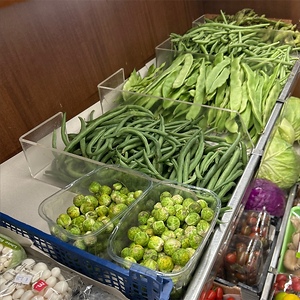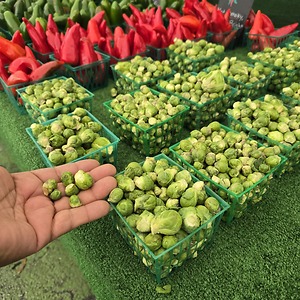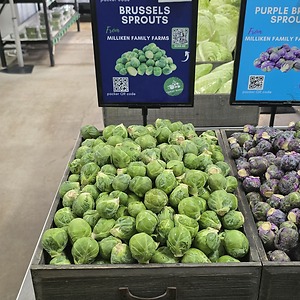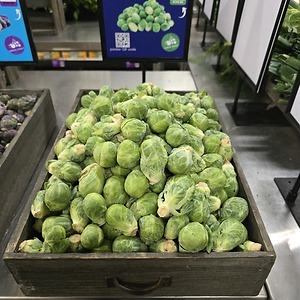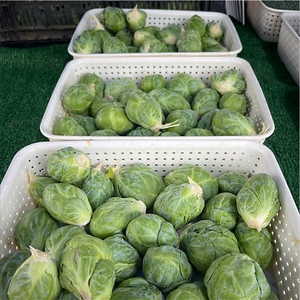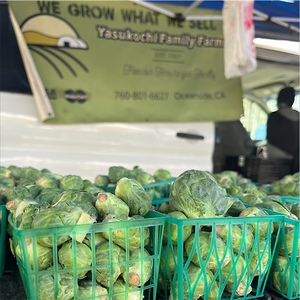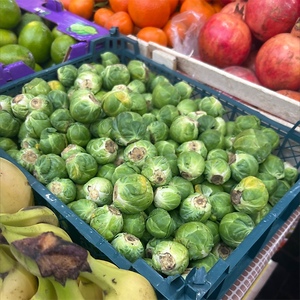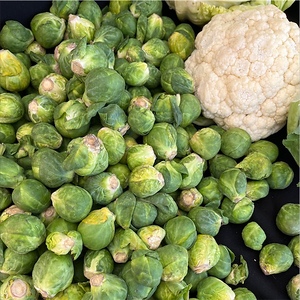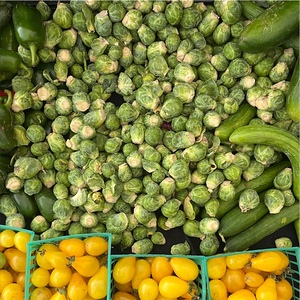

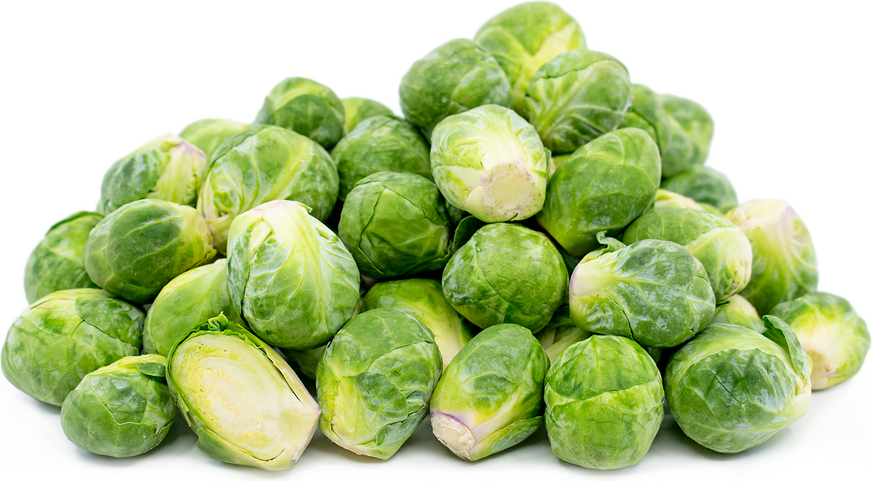
Baby Brussels Sprouts
Estimated Inventory, 12 ct : 2.67
This item was last sold on : 04/12/25
Description/Taste
Baby Brussels sprouts are a small, averaging less than three centimeters in diameter, and are young buds that have been harvested before full maturity. The sprouts grow on upright, thick, and fibrous green stalks, and each bud has a round to oval appearance, slightly tapering towards the stem end. The sprouts are comprised of layers of tightly packed leaves, and Baby Brussels sprouts are dense with little to no air pockets in the center of the bud. The outer leaves range in color from green to dark green with faint spots of yellow and white at the sprout’s base and have a smooth and pliable consistency. Raw Baby Brussel sprouts should have a crisp, crunchy, and firm texture. The sprouts are distinctly sweeter, lacking the astringency and bitterness often found in larger sprouts, and have nutty, earthy, and vegetal nuances. When cooked, Baby Brussels sprouts will soften into a tender and slightly chewy consistency and develop mellow, savory, sweet, and nutty undertones.
Seasons/Availability
Baby Brussels sprouts are available in the late fall through early spring.
Current Facts
Baby Brussels sprouts, botanically classified as Brassica oleracea, are tiny, edible buds belonging to the Brassicaceae family. The sprouts grow along upright stems of a leafy plant that can reach 60 to 91 centimeters in height and are defined as a type of axillary bud, forming where the leaf meets the stalk. Baby Brussels sprouts grow upward along the stalk, and each stalk can develop 15 to 20 sprouts. The descriptor Baby Brussels sprouts is given to sprouts that have been harvested when they are young and small before they have reached maturity. The sprouts are distinct from regular Brussels sprouts as they are smaller, do not need to be peeled, are fast-cooking, and contain a sweeter flavor than larger sprouts. Baby Brussels sprouts are favored among consumers for their versatility, incorporated into fresh and cooked preparations. The sprouts are also commercially cultivated, harvested, and frozen into prepackaged bags as convenience food.
Nutritional Value
Baby Brussels sprouts are a source of fiber to regulate the digestive tract, vitamin A to maintain healthy organ functioning, and vitamin C to strengthen the immune system while reducing inflammation. The sprouts also provide calcium to build strong bones and teeth, vitamin K to assist in faster wound healing, and other nutrients, including copper, folate, selenium, potassium, magnesium, phosphorus, manganese, and iron.
Applications
Baby Brussels sprouts have a sweet, nutty flavor suited for fresh or cooked preparations. The sprouts should be washed thoroughly but do not need to be peeled before use. They can be shaved into slaws, shredded and tossed into salads, or thinly sliced and incorporated into appetizers as a crisp addition. Baby Brussels sprouts can also be cooked to develop a softer consistency, popularly braised, lightly steamed, or sauteed in oils, butter, and sauces. The tiny nature of the sprouts allows them to cook quickly, creating a tender chewiness in stir-fries, or the sprouts can be roasted or grilled as an accompaniment to meats. Baby Brussels sprouts can also be cooked in the microwave, halved into gratins, or cooked in skillets with onions, herbs, and cheeses. Baby Brussels sprouts pair well with nuts such as pine, buttered pecans, and walnuts, herbs including thyme, mint, rosemary, and parsley, cheeses such as pecorino, taleggio, and alpine, meats such as pork, beef, and poultry, mushrooms, peppers, and garlic. Whole, unwashed Baby Brussels sprouts will keep 4 to 5 days when stored in a loosely ventilated container in the refrigerator. The baby sprouts can also be shocked in cold water, dried, and frozen in a sealed container for one year.
Ethnic/Cultural Info
Baby Brussels sprouts are a popular item found in the frozen food section of grocery stores. The small sprouts are often advertised as being quickly cooked in the bag using the microwave, and the sweet, nutty buds are favored as a convenience item. Vegetables have been preserved using various methods such as pickling, drying, or fermenting throughout history, but frozen vegetables traditionally thawed into a softer, unpleasantly mushy texture, creating frustration among consumers. The art of freezing was localized to regions with frigid temperatures, as the cold air would almost instantly freeze the food items, preserving their texture. Clarence Birdseye, one of the creators of frozen vegetables in North America, learned this ancient freezing technique from his time as a fur trapper in Canada. Birdseye worked closely with the Inuit people from 1912 to 1926 and learned how to instantly freeze fish to extend their shelf life. This process sparked an idea to flash freeze other food products, including vegetables, and in 1927 Birdseye applied for a patent on his first freezing machine. By 1928, Birdseye improved on his first machine and added a double belt freezer to start his frozen foods company in 1930. Frozen foods became the dominant consumer food item during World War II, as canned goods were reserved for soldiers overseas. The American government encouraged the sale of frozen goods over canned, changing consumer preferences. After the war, the selection of frozen foods continued to expand, and vegetables such as Baby Brussels sprouts were included as a healthy, easy to prepare vegetables.
Geography/History
Brussels sprouts are believed by experts to be descendants of wild cabbage-like species native to the Mediterranean. Over time, these plants were cultivated throughout the Mediterranean, and the improved selections were introduced to northern Europe sometime during the 5th century. Brussels sprouts were cultivated in Brussels, Belgium, around the 13th century, and by the 16th century, they had expanded in popularity, increasing production. The sprouts were given their Brussels moniker in the 18th century and were named by the French. Brussels was bestowed upon the sprouts, as the plant, at the time, was popularly grown in Belgium. In the 19th century, Brussels sprouts were carried to the New World and were planted in Louisiana by French settlers, later offered to Americans through home seed catalogs. At the time, the Brassica was favored for its nutritional properties, and since its acceptance in the New World, Brussels sprouts have expanded in cultivation to be mainly grown in coastal California and New York within the United States. Baby Brussels sprouts have been present since the beginning of Brussels sprout cultivation. The tiny sprouts are harvested before they mature and maintain a sweet and tender taste. The baby sprouts also became popular in the United States in the 1940s with the rise of frozen foods. Today Baby Brussels sprouts are grown in home gardens worldwide and are commercially produced in the United States, Mexico, and the Netherlands.
Featured Restaurants
Restaurants currently purchasing this product as an ingredient for their menu.
| Black Radish | San Diego CA | 619-775-7412 |
| Catania La Jolla | La Jolla CA | 619-884-5350 |
| Omni Hotels | San Diego CA | 619-231-6664 |
| Park Hyatt Aviara (Ember & Rye) | Carlsbad CA | 760-448-1234 |
| Crudo Cevicheria & Oyster Bar | San Diego CA | 619-313-9127 |
Recipe Ideas
Recipes that include Baby Brussels Sprouts. One



